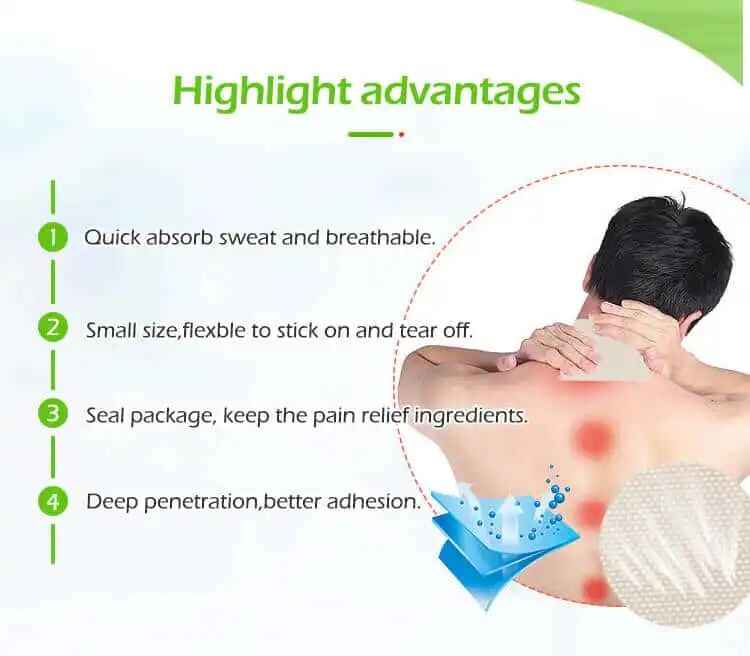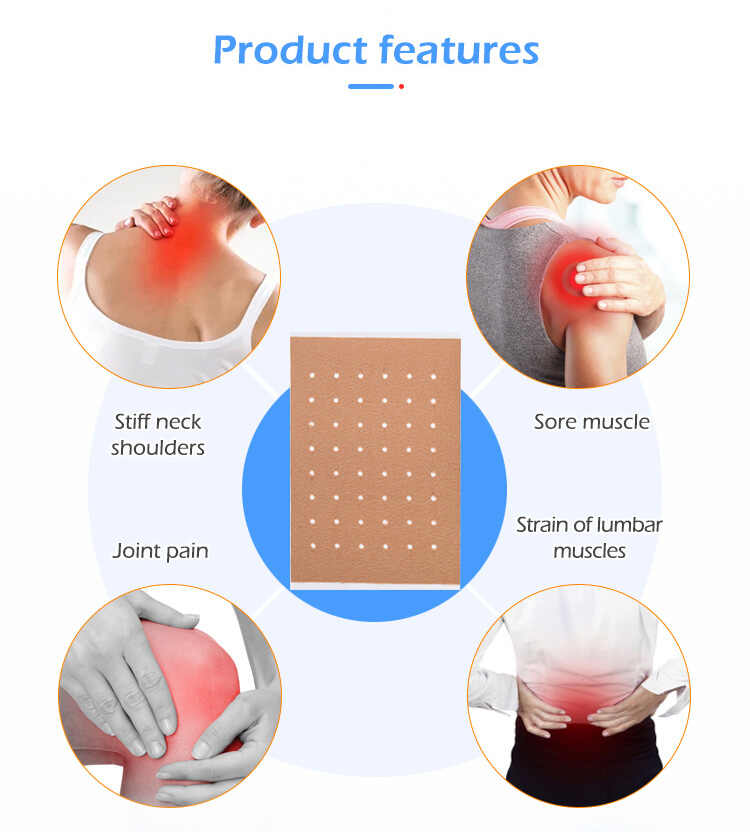How Can Chronic Pain Patches Manufacturers Stay Ahead of Market Trends?
In a competitive and rapidly evolving health and wellness industry, staying ahead of market trends is not optional—it’s essential. For any Chronic Pain Patches Manufacturer, anticipating consumer behavior, adopting innovation, and remaining agile in production and branding are the keys to long-term success. As consumer preferences shift toward non-invasive and convenient pain management solutions, the demand for Custom Chronic Pain Patches and Private Label Chronic Pain Patches is growing steadily.

In this article, we’ll explore how Chronic Pain Patches Manufacturers, Chronic Pain Patches OEM providers, and Chronic Pain Patches Suppliers can proactively respond to changes in the marketplace and ensure they are not only meeting current demand but also shaping future trends.
1. Understanding Market Dynamics: The Foundation of Innovation
To stay ahead, a Chronic Pain Patches Manufacturer must start with a deep understanding of the market. This includes tracking:
Consumer preferences: Organic ingredients, sustainability, convenience
Competitor strategies: Product innovation, pricing, distribution channels
Regulatory updates: FDA, ISO, CE requirements
Technological advancements: Smart patches, nano-technology, extended-release systems
Data-driven market research allows manufacturers to identify emerging demands and position their Custom Chronic Pain Patches accordingly.
2. Investing in R&D and Advanced Technology
Innovation is the lifeblood of staying competitive. Leading Chronic Pain Patches OEM providers invest consistently in research and development to:
Develop longer-lasting, more effective pain relief formulas
Incorporate new delivery systems such as transdermal nanocarriers
Improve adhesive performance for various skin types
Explore heat-activated or smart patch technologies
Case in Point:
A Chronic Pain Patches Supplier that introduced a patch with time-release herbal compounds saw increased B2B interest from private wellness brands looking for differentiation. Innovation doesn't just meet demand—it creates new markets.
3. Customization: The Key to Consumer-Centric Manufacturing
Today’s consumers want personalized solutions. Manufacturers that offer Custom Chronic Pain Patches gain a significant competitive edge.
Areas of Customization:
Ingredients: Herbal, pharmaceutical, or hybrid
Sizes and shapes: Tailored for back, shoulder, knee, or neck application
Patch duration: 4-hour, 8-hour, 24-hour effects
Packaging and branding: Fully private label with multilingual options
Providing robust customization options enables Chronic Pain Patches OEM companies to serve niche segments, from athletes and seniors to office workers and postpartum women.
4. Offering Scalable Private Label Solutions
Private Label Chronic Pain Patches are a fast-growing segment. Startups and established brands are seeking turnkey production partners who can bring their product to market without the need for owning manufacturing facilities.
A Chronic Pain Patches Manufacturer can stay ahead by offering flexible and scalable private label programs that include:
Product design and formulation
Packaging development
Regulatory documentation
Dropshipping and logistics support
This end-to-end service model positions the manufacturer as a strategic partner, not just a vendor.
5. Embracing Clean, Natural, and Sustainable Formulations
The modern consumer is ingredient-conscious and sustainability-driven. Manufacturers that embrace these values can:
Attract eco-conscious brands
Comply with stricter international regulations
Position their Custom Chronic Pain Patches as premium products
Key Strategies:
Use biodegradable materials and sustainable adhesives
Highlight "clean label" ingredients with no harsh chemicals
Obtain certifications like USDA Organic or Ecocert
Chronic Pain Patches Suppliers that pivot to clean and green manufacturing practices set themselves apart in a health-first market.
6. Building Strong B2B Relationships
For a Chronic Pain Patches Manufacturer, long-term success relies heavily on trust and performance in B2B relationships. To build and maintain strong partnerships with brands and distributors:
Provide consistent product quality and compliance
Be transparent about sourcing and manufacturing processes
Offer marketing and educational support
Maintain flexibility in MOQs and production timelines
B2B clients appreciate responsiveness and innovation—traits that turn suppliers into irreplaceable partners.
7. Leveraging Digital Marketing and Online Presence
Manufacturers can no longer rely solely on trade shows and referrals. A strong online presence and smart digital marketing strategy help reach global clients faster.
Best Practices:
Optimize your website for keywords like Chronic Pain Patches Manufacturer, Chronic Pain Patches OEM, and Private Label Chronic Pain Patches
Use LinkedIn and B2B directories to attract potential partners
Publish educational content and case studies showcasing your expertise
Offer online catalogs and RFQ options
Digital visibility directly supports business development and positions the manufacturer as an industry thought leader.
8. Navigating Regulatory Landscapes Proactively
The pain relief category is highly regulated, especially when entering new markets. Manufacturers must stay updated on evolving regulations in:
The U.S. (FDA)
The EU (CE Mark)
Canada (Health Canada)
Asia-Pacific markets (Japan PMDA, China NMPA)
By preemptively aligning production and documentation with global standards, Chronic Pain Patches OEM providers can simplify exports and reduce legal risks for their clients.
9. Continuous Quality Improvement
To gain a reputation as a top-tier Chronic Pain Patches Supplier, quality assurance must be ingrained in every part of the operation:
Raw material selection
Production line cleanliness
Testing protocols (adhesion, absorption, stability)
Post-market surveillance
Certifications like ISO 13485 and GMP not only ensure safety but also boost brand credibility in the eyes of clients and regulators.
10. Monitoring Consumer Feedback and Product Performance
One of the most powerful tools for innovation is customer feedback. Leading Chronic Pain Patches Manufacturers set up systems to gather data from:
Direct clients (brands, distributors)
End users via brand partners
Online reviews and social listening tools
By analyzing this data, manufacturers can improve patch performance, introduce new variants, and reduce churn among private label clients.
Conclusion: A Roadmap for Chronic Pain Patches Manufacturers
Staying ahead of market trends isn’t about guesswork—it’s about strategy, investment, and a commitment to innovation. For a Chronic Pain Patches Manufacturer, the future belongs to those who:
Embrace Customization
Lead with Innovation
Deliver Quality
Align with Sustainability
Foster Strategic B2B partnerships
Whether you’re serving startups or global brands, offering Custom Chronic Pain Patches and Private Label Chronic Pain Patches through a forward-thinking Chronic Pain Patches OEM model can help you outpace competitors and capture new market share.
The brands that succeed will do so by choosing a Chronic Pain Patches Supplier who understands both the science of manufacturing and the art of market strategy.
Related Questions and Answers
Q1: What trends are shaping the future of Chronic Pain Patches manufacturing?
A: Clean-label ingredients, personalization, smart patches, and eco-friendly materials are key trends.
Q2: How can a Chronic Pain Patches Manufacturer offer value to B2B partners?
A: Through consistent quality, customization options, regulatory support, and private label flexibility.
Q3: Why is customization important for Chronic Pain Patches OEM providers?
A: It allows them to meet diverse consumer needs and help clients differentiate their brand in a crowded market.
Q4: How can a Chronic Pain Patches Supplier improve product performance?
A: By investing in R&D, gathering user feedback, and using advanced delivery technologies.
Q5: What certifications should I look for in a reliable Chronic Pain Patches Manufacturer?
A: GMP, ISO 13485, CE, and FDA registrations for compliance and product safety assurance.






